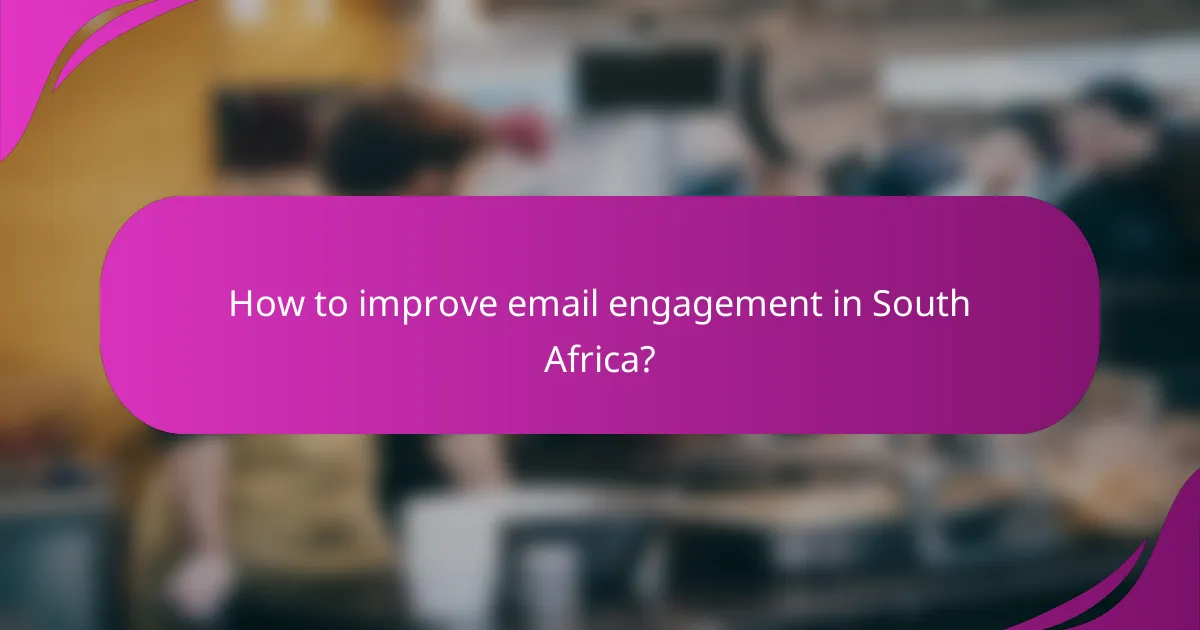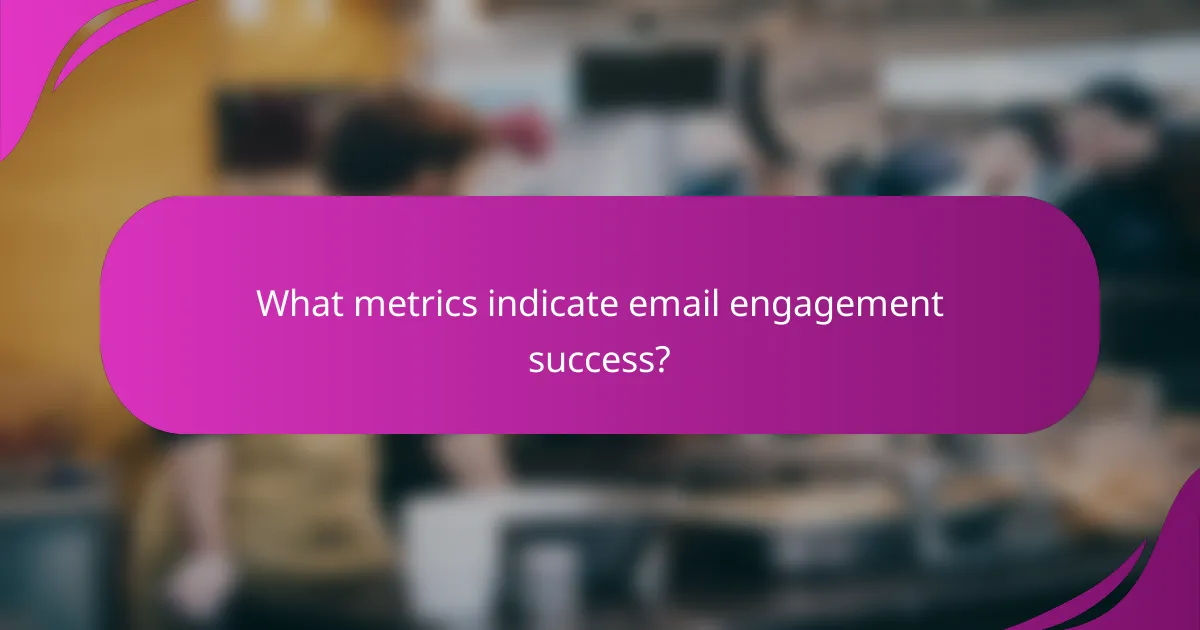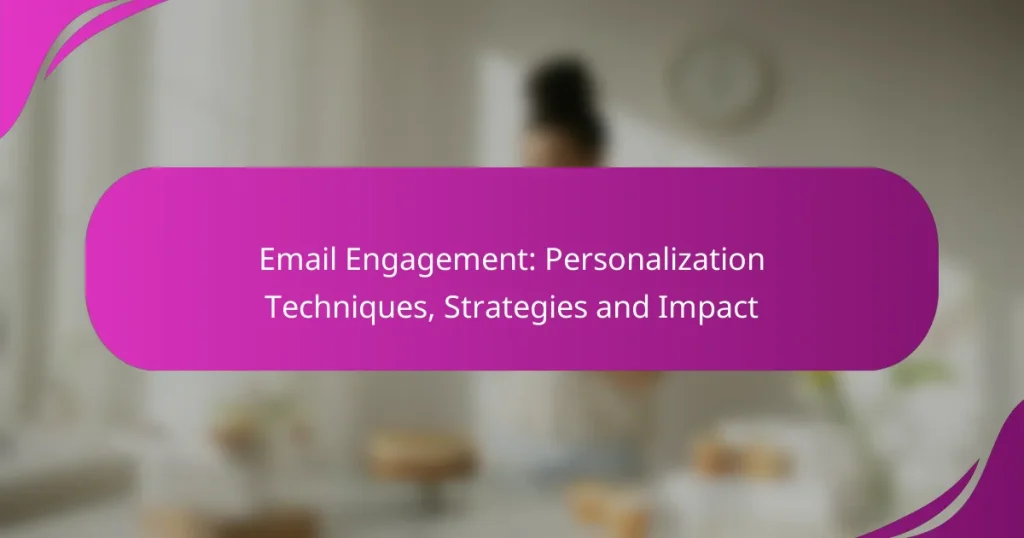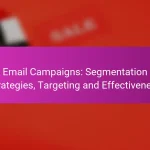Email engagement can be significantly improved through effective personalization techniques that resonate with individual preferences. By tailoring content to meet the unique needs of recipients, marketers can enhance open and click-through rates, ultimately leading to greater customer satisfaction and interaction. Implementing strategies such as A/B testing and optimizing send times further amplifies these benefits, ensuring that emails are not only opened but also engaged with meaningfully.

How to improve email engagement in South Africa?
To enhance email engagement in South Africa, focus on personalization techniques that resonate with your audience. Tailoring content to individual preferences can significantly boost open and click-through rates, leading to better overall engagement.
Personalized subject lines
Personalized subject lines can dramatically increase open rates. By including the recipient’s name or referencing their past interactions, you create a sense of relevance and urgency. For example, a subject line like “John, your exclusive offer awaits!” can be more enticing than a generic one.
Keep subject lines concise and engaging, ideally under 50 characters, to ensure they display well on mobile devices. A/B testing different personalized approaches can help identify what resonates best with your audience.
Dynamic content based on user behavior
Dynamic content allows you to tailor email messages based on user behavior, such as past purchases or browsing history. This approach ensures that recipients receive information that is relevant to their interests, increasing the likelihood of engagement.
For instance, if a customer frequently buys sports gear, sending them a targeted email featuring new arrivals in that category can enhance their experience. Implementing this requires robust data tracking and segmentation capabilities.
Segmentation by demographics
Segmenting your email list by demographics, such as age, gender, or location, enables more targeted messaging. This practice allows you to craft emails that speak directly to the interests and needs of specific groups, improving engagement rates.
For example, sending different promotions to younger audiences versus older ones can yield better results. Aim for at least three to five segments based on key demographic factors to start seeing meaningful differences in engagement.
Automated follow-ups
Automated follow-ups are essential for maintaining engagement after the initial email. Setting up a series of follow-up emails can remind recipients of your offerings and encourage them to take action.
Consider a sequence that includes a thank-you email after a purchase, a feedback request, and a reminder about related products. Timing is crucial; sending follow-ups within a few days of the initial interaction often yields the best results.
Interactive elements in emails
Incorporating interactive elements, such as polls, quizzes, or clickable images, can significantly enhance engagement. These features encourage recipients to interact with your content rather than passively read it.
For example, a simple poll asking for feedback on a recent purchase can create a two-way conversation. Ensure that these elements are mobile-friendly, as many users access emails on their smartphones.

What are effective personalization techniques for email marketing?
Effective personalization techniques for email marketing enhance engagement by tailoring content to individual recipients. These methods can significantly improve open rates, click-through rates, and overall customer satisfaction.
Using recipient’s name
Incorporating the recipient’s name in the subject line or greeting can create a sense of familiarity and connection. This simple technique can increase open rates by making emails feel more personal and relevant.
To implement this, ensure your email platform supports dynamic fields for names. Avoid overusing this tactic, as it can come off as insincere if not done thoughtfully.
Behavioral triggers
Behavioral triggers involve sending emails based on specific actions taken by the recipient, such as browsing products or abandoning a cart. This approach allows for timely and relevant messaging that can prompt further engagement.
Common triggers include welcome emails, reminders for abandoned carts, or follow-ups after a purchase. Analyze user behavior to refine your triggers and ensure they align with customer expectations.
Location-based offers
Location-based offers utilize the recipient’s geographical information to provide relevant promotions or content. This technique can drive foot traffic to local stores or highlight region-specific products.
Consider segmenting your email list by location to tailor offers effectively. Ensure compliance with local regulations regarding data privacy when collecting and using location data.
Purchase history integration
Integrating purchase history into your email campaigns allows for personalized product recommendations and targeted promotions. By analyzing past purchases, you can suggest complementary items or remind customers of items they may need to replenish.
Utilize data analytics to segment customers based on their buying patterns. This approach not only increases the likelihood of repeat purchases but also enhances customer loyalty by showing that you understand their preferences.

What strategies enhance email engagement rates?
Strategies that enhance email engagement rates focus on personalization, timing, and content relevance. Implementing techniques such as A/B testing, optimizing send times, utilizing user-generated content, and incorporating feedback loops can significantly improve how recipients interact with emails.
A/B testing subject lines
A/B testing subject lines involves sending two variations of an email to different segments of your audience to determine which subject line generates higher open rates. This method allows marketers to analyze the effectiveness of different wording, lengths, and styles. Aim for a sample size that represents your audience, and consider testing one variable at a time for clearer insights.
Common practices include using action-oriented language, creating a sense of urgency, or personalizing the subject line with the recipient’s name. Regularly testing and refining your approach can lead to incremental improvements in engagement.
Optimizing send times
Optimizing send times means scheduling emails when your audience is most likely to engage with them. Research suggests that weekdays, particularly Tuesday through Thursday, often yield better open rates, but this can vary by industry and audience demographics. Testing different times, such as early mornings or late afternoons, can help identify the sweet spot for your specific audience.
Utilizing analytics tools can provide insights into when your emails are opened most frequently. Adjusting your send times based on these insights can lead to improved engagement and higher conversion rates.
Utilizing user-generated content
Utilizing user-generated content (UGC) involves incorporating testimonials, reviews, or images from your customers into your emails. This strategy not only enhances authenticity but also fosters a sense of community among your audience. Highlighting real customer experiences can significantly increase trust and engagement.
Encourage customers to share their experiences through social media or direct submissions, and feature this content in your email campaigns. This approach not only enriches your content but also encourages further interaction from your audience.
Incorporating feedback loops
Incorporating feedback loops means actively seeking and responding to customer feedback regarding your email campaigns. This can be done through surveys, direct questions in emails, or monitoring engagement metrics. Understanding your audience’s preferences allows for continuous improvement in your email strategy.
Consider implementing a simple rating system or a quick survey link in your emails to gather insights. Regularly reviewing this feedback can help you adjust your content, design, and frequency, ultimately leading to better engagement rates.

What metrics indicate email engagement success?
Email engagement success can be measured through several key metrics that reflect how recipients interact with your emails. The most important indicators include open rates, click-through rates, conversion rates, and unsubscribe rates, each providing insights into different aspects of engagement.
Open rates
Open rates measure the percentage of recipients who open your email compared to the total number of emails delivered. A good open rate typically ranges from 15% to 25%, depending on the industry. Factors influencing open rates include subject lines, sender reputation, and timing of the email.
To improve open rates, consider A/B testing different subject lines and sending times. Avoid spammy language and ensure your emails are optimized for mobile devices, as many users check emails on their phones.
Click-through rates
Click-through rates (CTR) indicate the percentage of recipients who click on one or more links within your email. A healthy CTR usually falls between 2% and 5%, but this can vary by sector. High CTRs suggest that your content resonates with your audience and encourages action.
To enhance CTR, include clear calls-to-action (CTAs) and ensure links are prominently placed. Personalizing content based on user preferences can also drive higher engagement, as recipients are more likely to click on relevant offers.
Conversion rates
Conversion rates reflect the percentage of email recipients who complete a desired action, such as making a purchase or signing up for a webinar. A typical conversion rate for email marketing is around 1% to 3%. This metric is crucial as it directly ties email engagement to business outcomes.
To boost conversion rates, ensure that your emails provide clear value and a seamless user experience. Use targeted messaging and follow up with personalized offers to encourage recipients to take action.
Unsubscribe rates
Unsubscribe rates indicate the percentage of recipients who opt out of your email list after receiving an email. A low unsubscribe rate, generally below 0.5%, is a positive sign of engagement. High unsubscribe rates may indicate that your content is not meeting audience expectations or that you are sending emails too frequently.
To minimize unsubscribe rates, regularly review your email frequency and content relevance. Providing options for recipients to customize their preferences can help maintain engagement without overwhelming them.

How does personalization impact email marketing?
Personalization significantly enhances email marketing by tailoring content to individual preferences, which leads to improved engagement and effectiveness. By addressing customers by name and recommending products based on past behavior, businesses can create a more relevant experience that resonates with recipients.
Increased customer loyalty
Personalized emails foster a stronger connection between brands and customers, leading to increased loyalty. When recipients feel valued through tailored content, they are more likely to engage with the brand and make repeat purchases.
To build loyalty, consider segmenting your email list based on customer behavior and preferences. For example, sending personalized birthday offers or exclusive discounts can enhance the customer experience and encourage long-term relationships.
Higher conversion rates
Personalization directly contributes to higher conversion rates by making emails more relevant to the recipient’s interests. Emails that include personalized product recommendations or tailored content can see conversion rates increase significantly compared to generic messages.
Utilize data analytics to understand customer preferences and behaviors. A/B testing different personalized approaches can help identify what resonates best with your audience, leading to optimized email campaigns that drive sales.


